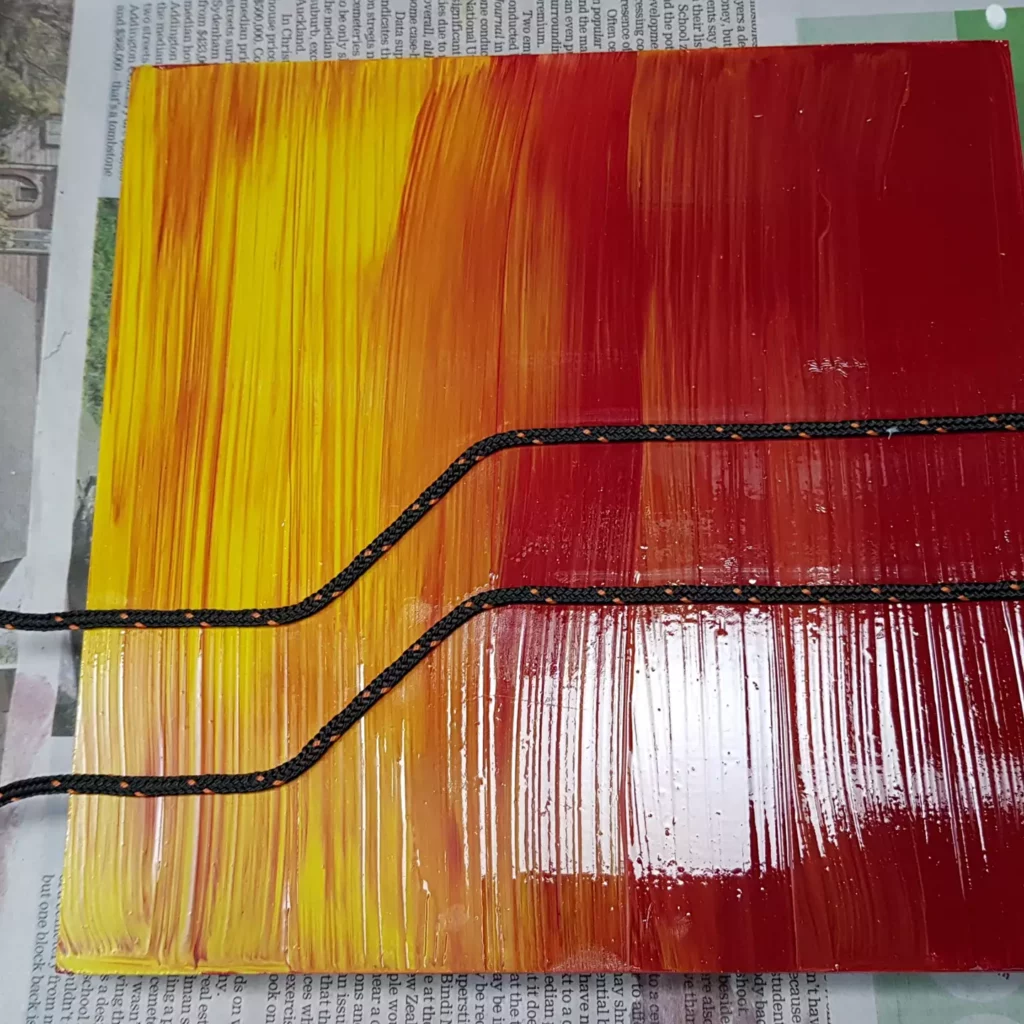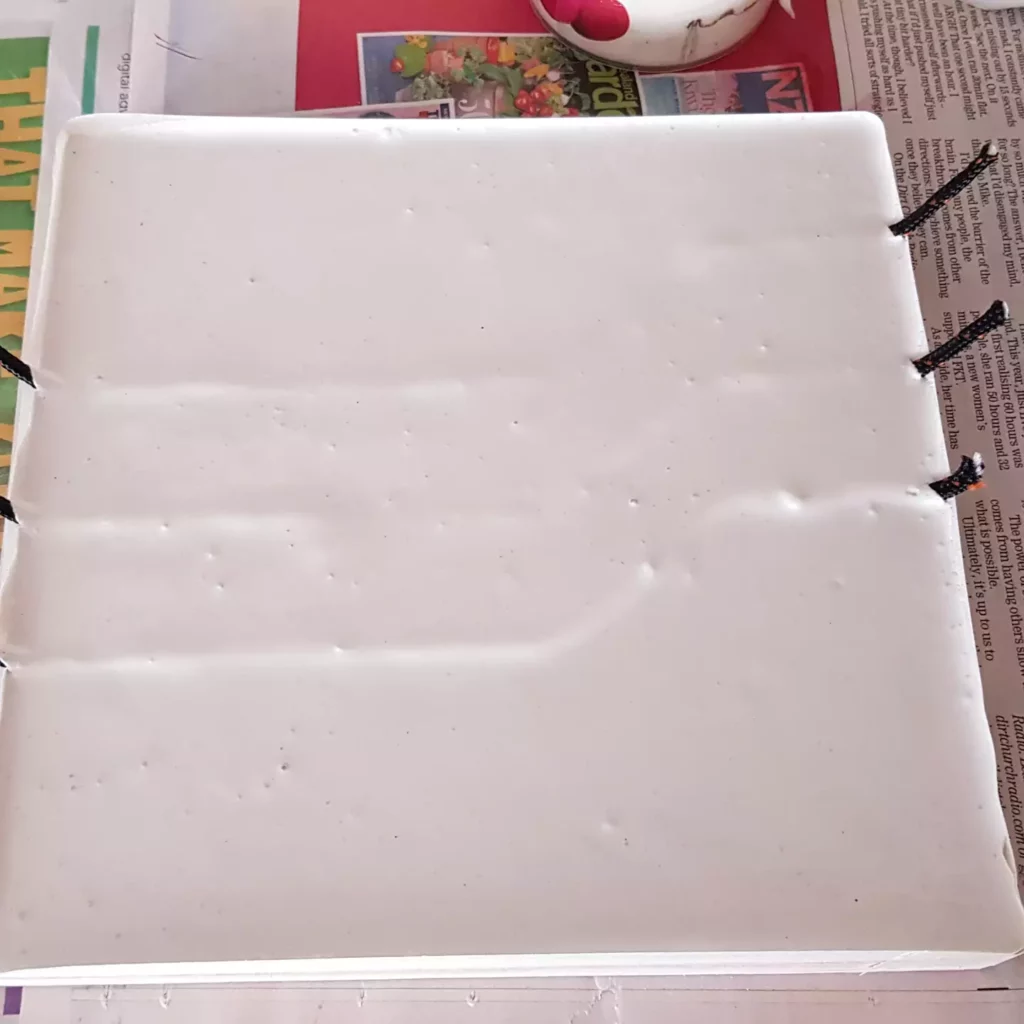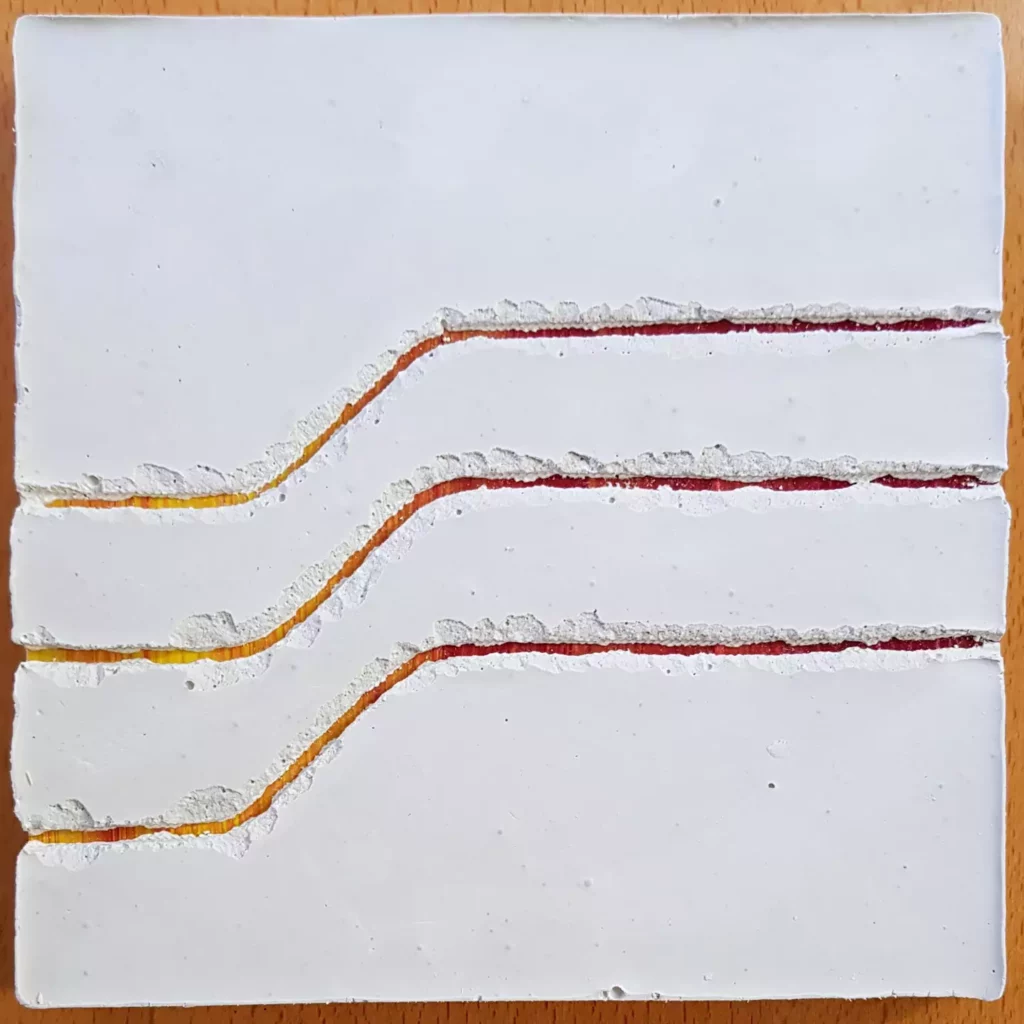Category: 213.157 Studio I (Art Lab)
Experiment
Testing out a few concepts…




Group discussion
Thinking about how we might evolve our work.
Sounds like we all need to do some experimentation.
Only two weeks left to get to a completed work…
Wiki tekau, Akomanga tua rua
Formative Assessment
Notes on my own work
What has worked for you? What was your best, or favorite, method?
Deeply layered collage is a messy, fun thing to do and I can see it having interesting possibilities that I’m already thinking through.
I like the idea of using a string/rope to pull through layers of paper. I’m interested to try a more fine grained approach. Perhaps apply a layer of colour, add drawings of people on newsprint on top, then use thin strings to pull through them aligned to the limbs, so that you get a kind of sinewy effect? Worth trying.
How could these methods reflect aspects of hakari through the resulting artworks?
I quite like the richness and deliberate nature of this technique, although it is destructive in nature. Hakari can be partly about displaying wealth, almost in a gratuitous way.
Why?
As to hākari, I can see a link here. A feeling that I’m adding richness to a work that’s ultimately then something of a sacrifice.
Note: I’ve no idea why I’m making this connection, but it does remind me of some Native American blood rituals. It’s the tearing through of something as the final act in the process. Probably an old movie called A Man Called Horse, which is a mixed up mess of a thing with a white guy playing the Native American lead, the ritual aspects borrowed from the wrong tribe, and so on.
How will you iterate on your earlier experiments to produce a final artwork? What research and further experimentation will be needed? How will you go about this?
While making in this way, I did have a number of things that I wasn’t entirely happy with, and also places where I wanted to try additional techniques:
I did not have much control over what was exposed on underlying layers. I think with my next piece this should be more deliberate.
Adding the string/rope back into the piece is what Bradford discussed in one of the interviews we watched. How might I do that?
Wiki tekau, Akomanga tua tahi
Group discussion
Sadly, I was the only person in my group who had time at the weekend to do anything.
7. Mark Bradford
Uses found materials.
Brings social and cultural issues into his work.
Grew up in what could be thought of as a matriarchal collective.
Initially worked in his mother’s hair salon.
Worked with hair papers – cheap, available.
Wants to keep the story complicated – no simplifications.
Works based on maps
Gotta admire the use of a planer!
Acknowledgment of people’s struggles – no turning away.
Abstract, but comes from material that’s “politically and socially charged”.
Builds on what’s been done before.
Constant learning and experimentation.
Builds time for experimenting into his life. 80/20 or 70/30: 20-30% time for experimentation.
Riots changed the physicality of his work and found items.
Dedicates time to giving back to his community.
Contemporary art for everyone – inviting the community to work with him.
“Hard won hope”
Artists deserving of a seat at the table.
“Don’t ask; demand.”
“I pillage my own work. I tear it down and build it up in traces.”
What do we know about Mark Bradford’s materials, methods, and processes?
“I pillage my own work. I tear it down and build it up in traces.”
Uses found materials. Urban materials
Worked with hair papers – cheap, available.
Wants to keep the story complicated – no simplifications.
Works based on maps
Gotta admire the use of a planer!
Builds on what’s been done before.
Constant learning and experimentation.
Builds time for experimenting into his life. 80/20 or 70/30: 20-30% time for experimentation.
“Necessity makes invention.”
Experimental
Layers
Abstract
Reductive(?) artmaking, creating by removing. (e.g sanding art gallery wall, tearing paper)
Gave himself permission to follow his voice, with no compromise
How do these relate to community and cultural context?
Brings social and cultural issues into his work.
Grew up in what could be thought of as a matriarchal collective.
Initially worked in his mother’s hair salon.
Acknowledgment of people’s struggles – no turning away.
Abstract, but comes from material that’s “politically and socially charged”.
Riots changed the physicality of his work and found items.
1980’s aids epidemic. Experienced as a gay youth in Los Angeles
Working with the community to help foster youth, feeding his success back to help his community
How material such as merchant posters suggest a timeline in culture
Contemporary art is for everyone, so you have to address access and need in your culture
“I don’t think strong ideas ever come through the front door.”
Taking remnants of our history and environment and trying to recompose and rebuild
How do all of these things connect and contribute to the ideas in the work?
Dedicates time to giving back to his community.
Contemporary art for everyone – inviting the community to work with him.
“Hard won hope”
Artists deserving of a seat at the table.
Use success in the market to give back, to help the disaffected youth, give them a sense of purpose through self expression
His work is externally optimistic and hopeful
“Don’t ask; demand.”
Work reflects the social issues of the neighbourhood as time has progressed
8. Haegue Yang
What do we know about Haegue Yang’s materials, methods, and processes?
Use of off the shelf parts, e.g window blinds, planters, lights, racks.
Crochet/Knitting
Diverse media
Geometry, abstractions, light and shadow
Movement
Particularly interested in the sphere as a burst of energy – a circular movement that doesn’t go anywhere
Sound to support from the background
Imaginary
How do these relate to community and cultural context?
Takes advantage of being in a gallery.
Elaborates on hidden meaning in mundane objects/experiences
Spatial/Temporal journey
Provoking imagination of the future
Interested in movement in multiple dimensions:
Physical movement
Emotional movement
Social and political movement
Mental and abstract movement
How do all of these things connect and contribute to the ideas in the work?
Geometry, abstract, light, shadow
Provoke thinking and abstractions
Focuses on marginal experiences and elaborates on them
Interestested in the multidimensionality of movement: physical, political, social.
Interested in the politics in the boring nature of objects
Focuses on experiences that are marginal and peripheral as these experiences are full of poetic possibilities
Using the space as more of a medium rather than just a space that focuses the attention on the work, active negative space
Wiki tua iwa, Akomanga tua rua
Group discussion
Breakout room sharing this time. Cool idea! I liked Josef’s cats, and it sounds like Kiah had fun trying to break a canvas down.
5. Hanne Lippard
Works with language, and discrepancies between spoken/written.
Collects fragments of language.
Rhythms, flow.
“About creating a tension around language in a quite specific way”.
Grew up in a bilingual family – between languages.
Sees rhythm/melody in text.
Hallucinogenic?
The place where she feels comfortable – performing a text – not as part of a discussion.
Ssssucessss
Why the pot plant?
Piece based on step counting – online psychology tests – assessment of own state?
Use of digital devices to broker our interactions with the world.
6. Rebecca Ann Hobbs
Uses music and dance in chosen places.
Re-present music outside its normal context?
Wiki tua iwa, Akomanga tua tahi
Group discussion
We first shared our work with the class for a minute each. So interesting!
So many different approaches to riffing on Dale Harding and Yoko Ono.
Got to get out of my track – the only difference between a rut and grave is depth. Need to break out of that!
Enjoyed how people allowed their environment and surroundings to influence their thoughts and feelings, and then responded to that. I feel that for myself I’m too much into technique, and not as much into the freedom of expression, so I need to push myself between those two modes.
3. Pati Solomona Tyrell
https://www.mutualart.com/Artist/Pati-Solomona-Tyrell/626906A4D6D12BF3
Art as a healing process.
Makes Art for himself.
Incorporates multiple mediums, including costume, film, etc.
Explored gender and sexuality in his earlier work.
Answering the questions he has about identity: male/female/other.
Looked at sasa? fafa? as performance.
Fluidity of space referencing fluidity of gender.
Looked at hierarchy of Samoan culture – expressed that queer is at lowest ranking.
Hard to be in a culture where others in culture don’t connect.
4. Angela de la Cruz
Painting as a container for her ideas.
Large scale canvases.
Break down paintings. Not sacred anymore.
Had a stroke, so can’t be as hands on.
A painting and a sculpture.
Humour is very important.
Paintings behaving badly.
I really like this work! Like the idea of breaking away from the normality of a framed canvas.
Wiki tua waru, Akomanga tua rua
Notes on the videos
1. Dale Harding
- Art as play.
- Grew up surrounded by art.
- Connected to his indigenous community.
- “If the work doesn’t relate to your family and your community then what’s the point?”
- Collaborating with cousins in his art practice.
- Belonging to place, but being separate from it.
- Nature and landscape part of who you are and what you do.
- Rewrite a displaced indigenous community back into wider community.
2. Yoko Ono
1 – the case for
- Learned music
- “A grapefruit in a world of park”
- Hybrid fruit as a metaphor
- Instructions as art
- Do the action, or just imagine – become the artist
- Dismantling of taboos
- Invitation to participate is a key part of her work
2 – reading from Grapefruit
Reminded me of Radiohead’s “Fitter Happier”.
3 – practice
- Simple materials
- Household items
- More interested in concept
- Brain as a driver of body
- Music as a human creation
- Vibration is important – frees you
- Sound as artform
- Fungibility of art
- Include change into art
- Art as a dynamic act; not a static object
- Enjoys every day
Wiki tua waru, Akomanga tua tahi
Introduction
Tuesday tutorial
Online because still at COVID Alert Level 2 Delta
Sucks that we have to do this for an interactive art class, but can’t be helped. Mostly worked! Not sure how it’ll work when we have to actively create as a group.
Hākari
A foundation of this course is Hākari. What do we mean by Hākari?
Initial definition
- Hākari is a process for balancing, settling and replenishing oneself and one’s community or whenua.
- It takes the form of a feast, which moves the powhiri proceedings from the formal to the informal, and through that movement cements future relationships.
- It is an opportunity for reciprocity and friendly rivalry to enhance the mana of the hosts and guests.
Group discussion
We had a class discussion on this, captured in a Google document.
